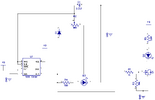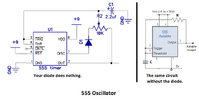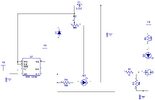MrDEB
Well-Known Member
Working on a method to have an adjustable flash on an LED neon strip.
Have attached the schematic for the test circuit, plan to use a 7805 to power the 555 but testing with a 9v battery I get 4 volts on the 555 output.
The issue is the gate has a maximum of 4v on the gate.
thinking of a voltage divider or Zener diode on the gate to avoid applying too much voltage to the gate.
I show 2 LEDs but D3 is just for testing. D2 will be a 12v LED neon strip. the 9v will be 12 v.
and yes the breadboard circuit works as showen
Have attached the schematic for the test circuit, plan to use a 7805 to power the 555 but testing with a 9v battery I get 4 volts on the 555 output.
The issue is the gate has a maximum of 4v on the gate.
thinking of a voltage divider or Zener diode on the gate to avoid applying too much voltage to the gate.
I show 2 LEDs but D3 is just for testing. D2 will be a 12v LED neon strip. the 9v will be 12 v.
and yes the breadboard circuit works as showen




